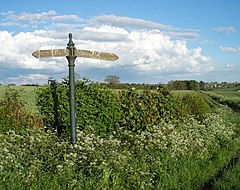Astwell
| Astwell | |
|---|---|
 Signpost commemorating the Astwell mill, 1935–1995 |
|
| Astwell shown within Northamptonshire | |
| Civil parish | |
| District | |
| Shire county | |
| Region | |
| Country | England |
| Sovereign state | United Kingdom |
| Post town | Brackley |
| Postcode district | NN13 |
| Police | Northamptonshire |
| Fire | Northamptonshire |
| Ambulance | East Midlands |
| EU Parliament | East Midlands |
| UK Parliament | |
Astwell is a hamlet in Northamptonshire, England. With Falcutt, it is part of the civil parish of Helmdon , but formerly Astwell was split between the parishes of Syresham and Wappenham. The hamlet is 6 miles (10 km) northeast of Brackley and 17 1⁄2 miles (28 km) by road southwest of the county town of Northampton. Today the hamlet contains little more than the Astwell Castle and a mill.
The De Wauncys were amongst the earliest holders of the Astwell manor since the Norman conquest of England. A Robert de Wauncy, who witnessed the Magna Carta, is documented as holding the manors of Astwell and Fancote (Falcutt) in the reigns of Henry III and Edward I. In 1453, a John Thorn of Brackley is recorded as being a witness to a grant of land in Astwell, Northamptonshire, The manor maintained close links to nearby Syresham. when the son of Arthur Brooke made an exchange, to Thomas Lovett II (d. 1492), the first of the Lovett family, who held it for the next hundred years.
The building of Astwell Castle is attributed to Thomas Lovett II. His grandson, George Shirley, lived here; and from his great-grandson, Robert Shirley, 1st Earl Ferrers, the manor descended to Washington Shirley, 5th Earl Ferrers (1722–78). The Astwell fields were enclosed in 1761, and two years later, the manor was sold to Richard Grenville-Temple, 2nd Earl Temple (1711–1779). He was succeeded by his nephew, George Nugent-Temple-Grenville, 1st Marquess of Buckingham (1753–1813), and his son, Richard Temple-Nugent-Brydges-Chandos-Grenville, 1st Duke of Buckingham and Chandos (1776–1839) was also associated with Astwell. In 1841, there were 6 houses and 46 inhabitants at Astwell.Richard Temple-Nugent-Brydges-Chandos-Grenville, 2nd Duke of Buckingham and Chandos (1797–1861) sold Astwell in 1850 to the Earl of Southampton, who sold it 12 years later to Lord Penrhyn (1800–86). In 1871, there were only 5 houses and 37 inhabitants, and, according to the Imperial Gazetteer of England and Wales of 1870–72 by John Marius Wilson, the hamlet had become a sportsmen's resort.
...
Wikipedia

